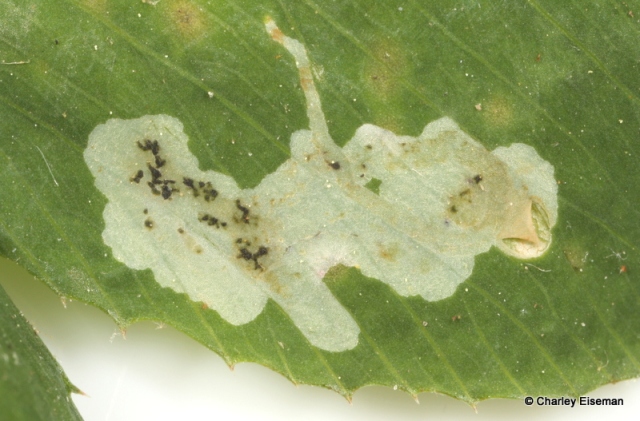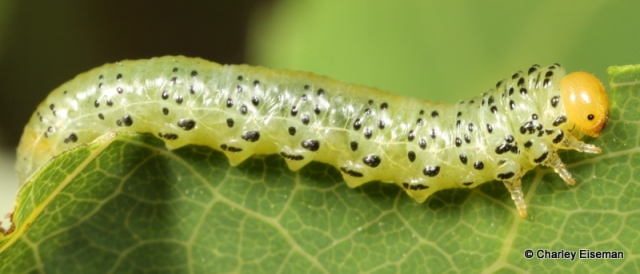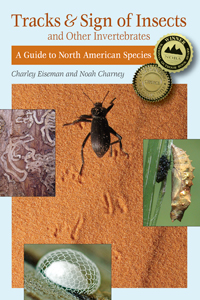Yikes, I let more than a week go by since my last report on the yard lists. I guess I’m due for an update! First the leafminers…
#32: Pegomya bicolor section (Anthomyiidae). On May 30 I saw the beginnings of mines on several curly dock plants (Polygonaceae: Rumex crispus) around the yard; several closely related Pegomya species have been reared from this host, of which P. bicolor is the one I’ve confirmed in my yard (reared from sheep sorrel, R. acetosella), but I suspect this one is actually P. solennis (the one I’ve reared every time I’ve collected leaf mines on “dock” species elsewhere). Pegomya mines are easily recognized by the white eggshells on the lower surface; in this case there were seven, but only two larvae were still in the mine—whether they left in search of more elbowroom or were eaten, I’m not entirely sure, but a couple of holes are evident in the upper surface of the mine.



There are at least two generations per year, so these larvae will become adults within a few weeks.

#33: Agromyza alnibetulae (Agromyzidae). On May 31 I spotted two mines on a little paper birch sapling (Betulaceae: Betula papyrifera) that we’ve decided to let grow, for now, in the sloping semi-wild garden on the west side of our house. Agromyza alnibetulae is a European species that has not been confirmed to occur in North America, but I’m guessing it’s the same species mining birch leaves here (and probably native rather than a recent introduction). The mine below was already empty, and the other one was aborted.

Luckily I succeeded in rearing this species last spring (from mines collected the previous spring), so we’ll learn the identity of this fly once Owen Lonsdale gets a chance to examine my specimens.

#34: Agromyza princei (Agromyzidae). On June 3, on my way to check on the chickens after a long walk in the woods, I was excited to see these mines on a black raspberry (Rosaceae: Rubus occidentalis) that is growing under the black cherry tree by our shed (the same clump of raspberry with some stems drooping due to Pegomya rubivora feeding inside).

I have only seen a single mine of Agromyza princei before, and the species is known only from the single adult that emerged from that mine a year after I collected it. The similar mines of A. vockerothi are common on all sorts of raspberries and blackberries, but I’m fairly sure these are A. princei because of the way they get a little blotchy toward the end, and have discrete, closely spaced frass grains almost from the very beginning; the one confirmed mine of A. princei was also found on black raspberry, and likewise on June 3. Agromyza vockerothi mines start showing up a little later in the season.
As of yesterday, all three larvae had exited their mines and formed puparia:


Back in April I showed mines of Landryia impositella (Scythrididae) on heart-leaved aster (Asteraceae: Symphyotrichum cordifolium) and said the adults would appear in June. I saw the first one on June 3, resting on an aster leaf right next to the house:

For several days I had been unable to locate the Marmara fraxinicola larva mining in the white ash branch in the vase on the kitchen counter; its path was no longer easy to trace as it doubled back on its previous mine. But on the morning of June 5, it had cut out the bark flap at the end of its mine, under which it was now spinning its cocoon:

Its completed mine extends 22 cm toward the tip of the branch from the eggshell, then 23 cm back down, and finally 19 cm back up, so that the cocoon is within 4 cm of the first turnaround point (shown above). Although the larva began feeding last summer, over a third of this length was mined after I collected the branch on May 22.
#35: Gracillariidae sp. Right after making that discovery about the Marmara larva, I was heading out for a walk when I spotted a sawfly larva munching on a paper birch leaf at the edge of the yard. Leaning in for a closer look, I noticed this underside tentiform mine on a neighboring leaf.


The larva will either pupate within the mine, revealing itself to be Phyllonorycter martiella, or it will exit to feed externally in a fold at the edge of the leaf, meaning it’s one of several Parornix species I have trouble distinguishing even after the adult has emerged. With any luck, I’ll have an update on this one soon…
#36: Glyphuroplata pluto (Chrysomelidae). Later on June 5 I was mowing a path in a part of the yard I hadn’t gotten to yet, when I stopped just short of running over an unusual grass I didn’t recognize:

I knelt down for a better look at the grass, which turned out to be some little Dichanthelium (not the large deertongue grass, D. clandestinum, that is common in our yard), and spotted a beetle mine just getting started at the tip of one of the leaves:

In a backlit view, you can see the larva inside, and you can see that it is depositing all its frass in the mine rather than pushing it out—indicating that it is Glyphuroplata pluto rather than Chalepus bicolor, an adult of which I saw on a nearby clump of deertongue grass a week earlier.

Yesterday when I was pointing out the mine to Julia there happened to be an adult G. pluto perched on the same clump of grass, but it dropped to the ground and disappeared as soon as I pointed at it, so I couldn’t get a photo. It looked like this though:

And right next to that clump of grass, along the arborvitae hedge, I noticed mines of two more new leafminer species for this year’s yard list.
#37: Caloptilia fraxinella (Gracillariidae). The young larva makes this epidermal mine on a white ash leaf (Oleaceae: Fraxinus americana) before exiting to feed in a leaf roll, just as with the C. serotinella larvae that are feeding on a nearby black cherry sapling.

This species overwinters as an adult, and every winter I find at least one on a wall in the house, evidently having been brought in with firewood.

#38: Calycomyza menthae (Agromyzidae). Several mines of this species are just getting started on the beebalm (Lamiaceae: Monarda didyma).

The initial narrow, linear portion of each mine will soon be obliterated by a big brown blotch. These larvae feeding now will emerge as adults within a few weeks.

#39: Liriomyza fricki (Agromyzidae). And finally, while picking greens in the hoop house for dinner, I found one mine of this species on white clover (Fabaceae: Trifolium repens), already vacated.

Most Liriomyza species have a quick turnaround, and the larva that made this mine could emerge as an adult any day now.

And now on to the sawflies! I’ve been seeing all sorts of adult sawflies around the yard, ranging from little black nondescript ones to big colorful ones that resemble ichneumon wasps. But I’m just focusing on larvae here, and in the past week I’ve found four more species, though I’ll have to rear all of them to adults to find out exactly what they are.
Sawfly #3. On May 31 I inspected a bigtooth aspen (Salicaceae: Populus grandidentata) sapling that has popped up in our yard, hoping to find leaf mines of Phyllocnistis populiella. No such luck, but I did find five of these sawfly larvae:

So far my review of North American sawfly host records has turned up 22 species that feed on poplars. I suspect these are something in the Euura/Nematus department, but have no way of looking them up. That’s why I’m working on a guide!
The next day, all five of the larvae I collected had finished feeding and burrowed into soil to pupate. The adults might emerge in a few weeks or not until next year, depending on who they are.
Sawfly #4. Also on May 31, the same paper birch sapling with the Agromyza mines was covered with these larvae:

Not quite as striking as the aspen larvae, but they do have distinctive little pink butts:


By June 4, some of these larvae had spun cocoons between leaves in the peanut butter jar I collected them in. The ones I’ve found wandering and moved to a jar of soil have all opted to burrow down before spinning. So far I know of 18 birch-feeding sawfly species; no idea which one this is.

As they approach maturity, the fecal pellets of these larvae start to be strung together on strands of silk, presumably because they’re starting to produce silk in preparation for spinning cocoons.

Meanwhile, on June 1, the Acordulecera larvae I found on red oak had molted to bluish prepupae and were likewise ready to burrow and spin cocoons:

Sawfly #5. Here’s the larva I found on paper birch on June 5 next to the gracillariid leaf mine—much larger than the above species; also solitary, without the pink butt, and with a distinctive stripe behind its eye.

When I got back from my walk that had been delayed a few minutes by stopping to collect and photograph this larva, it had molted and lost the stripe on its head.


I thought it might be done eating, so I put it (along with its leaf) in a jar of soil. But an hour later it was back to munching away, and its stripe was coming back. (In this photo it has a few grains of sand on it from having been dropped in the soil.)

Sawfly #6. Yesterday evening after dinner, Julia and I were gazing down from the porch at the semi-wild garden with the birch sapling, and I noticed that some of the lady ferns (Athyriaceae: Athyrium angustum) had been nibbled a bit. After staring for a few moments, I spotted a sawfly larva resting on top of one of the fronds. I went out with a camera and a peanut butter jar, hoping to photograph the larva in situ and then collect it for rearing, but as soon as I started to bend down for a photo, it pulled a “stop, drop, and roll” and vanished from sight. I spent several minutes scouring the ground for it, and then gave up and started scouring the fronds to see if I could find another larva, but only found this shed skin:

Then I realized I had damaged one of the precious wood hyacinths in the process of searching for the larva, and while I was kicking myself for that, I saw the larva looking at me from the top of one of the hyacinth leaves, which it had climbed up in a failed attempt to get back to its host plant.

Once I had it safely inside, I got some pictures of it on a lady fern frond…

…and when I was done with that I discovered another tiny larva, presumably a younger example of the same species, wandering around on my photography plate.

Two sawflies that occur in North America are known to feed on lady fern in Europe. Heptamelus dahlbomi has only been found in British Columbia and is a stem borer, so this obviously isn’t that; Strongylogaster macula has been found in both British Columbia and Ontario (and possibly elsewhere; I’m just going on the information in the 1979 Catalog of Hymenoptera at this point), and the larva shown at the bottom of this page does look similar to my larger one. I’ve never yet managed to rear a fern-feeding sawfly; they need to bore into wood to pupate and then be kept over the winter. We’ll see how it goes this time…
And incidentally, as of yesterday, the Sterictiphora larva I found on May 28 (which I did not collect) was still munching away on the same black cherry leaf, having endured all sorts of weather including a couple of thunderstorms. Its initial “curious winding slit” was long ago obliterated by its subsequent feeding. I took this photo on June 5:

For the edible plant list, I’ve added three more species since the last post:
59. Canada lettuce (Asteraceae: Lactuca canadensis) – leaves
60. Honeyberry (Caprifoliaceae: Lonicera caerulea) – fruits (the first couple were just barely ripe)
61. Lady’s thumb (Polygonaceae: Persicaria maculosa) – leaves and flowers
The plum curculios (Curculionidae: Conotrachelus nenuphar) have left their marks on a lot of our developing fruits, including this Asian pear:

Hopefully there are still some fruits left for us this summer and fall. In the past the curculios have caused a lot of plums to drop prematurely, but they need to be thinned out some anyway. It’s the raccoons that do the real damage. Here’s an adult plum curculio I found on the kitchen wall one spring:




I want to go for a walk with you and Julia sometime. We can cover maybe a quarter of a mile in three hours! And find four species that are new to science!
That’s an ambitious pace!
Pingback: The Yard List(s), Part 11 | BugTracks
Pingback: The Yard List(s), Part 12 | BugTracks
Pingback: The Yard List(s), Part 15 | BugTracks
Pingback: The Yard List(s), Part 17 | BugTracks
Pingback: First sawflies of the season! | BugTracks
Pingback: Another writing season begins! | BugTracks
Pingback: The Name Game | BugTracks